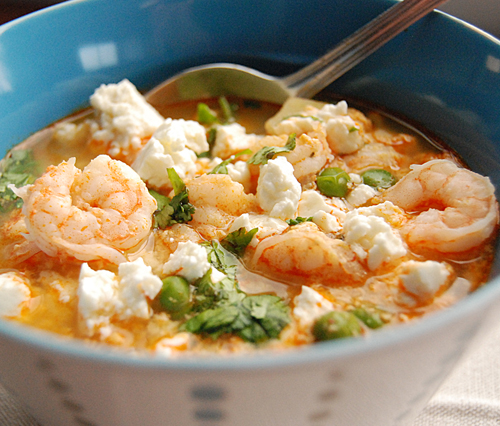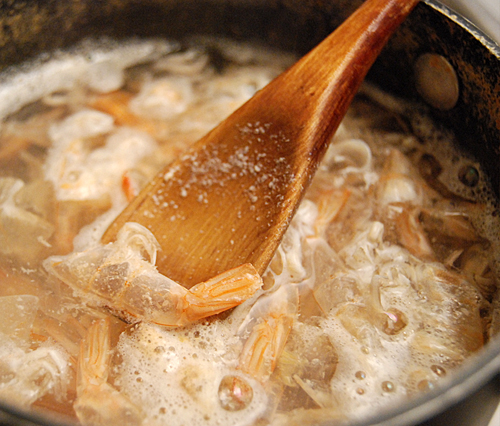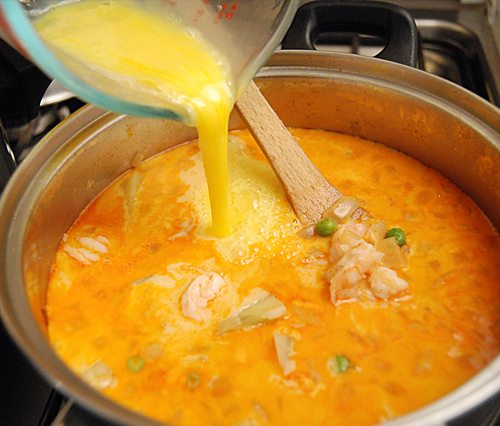Make this delicious ancestral soup part of your healthy recipe repertoire
One of Peru’s most emblematic dishes, this homey chowder is a flavorful main course in any season. Its roots are steeped in the southern city of Arequipa, where fresh shrimp are gathered from the Majes and Ocoña Rivers and crustaceans feed on algae.
The dish goes back to Incan times and is characteristic of the cooking in this part of the country, known for its love of chilies and spices. This rustic soup’s flavor explodes because of its seasoning with chili pastes and a rich shrimp stock, tamed by the creaminess of the potatoes and evaporated milk.
There are numerous variations of the base recipe, ranging from adding pieces of corn cobs and huacatay leaves (a wild Andean mint) to fava beans and tomato paste. However, the base of shrimp, chili, stock, and dairy never changes. Be sure to use meaty shrimp for the best flavor and yellow potatoes if available. The chili pastes can be found at Latin grocers or ordered online. Yield: 4 servings
Ingredients
2 pounds cleaned raw shrimp, shells reserved
6 cups water
2 tablespoons olive oil
1 large onion, finely chopped
1 garlic clove, thinly sliced
1 tablespoon panca chili paste (substitute: tomato paste)
1 teaspoon yellow chili paste
1 cup fresh or frozen, peas
1 pound potatoes, peeled and cut into 1-inch cubes
1 tablespoon sea salt
1 cup evaporated milk
1 teaspoon oregano
2 eggs, lightly beaten
1/2 cup crumbled queso fresco, or farmer’s cheese, for garnish
1 tablespoon cilantro, for garnish
Cover shells with water in saucepan. Bring to boil; Simmer 15 minutes. Puree shells with cooking liquid; strain. Reserve 4 cups.
Heat oil in large pot over medium heat. Add onion and garlic; stir 2 minutes. Incorporate chili pastes. Reduce heat; stir until onion softens. Add shrimp stock to mixture; simmer. Cook peas, potato chunks, till tender. Add salt.
Stir in milk, oregano, and shrimp over low heat,5 minutes. In a slow stream, add eggs to form ribbons. Garnish with queso fresco and cilantro; serve.
Cooking Tips
Make Shrimp Stock
- Let liquid thoroughly cool before blending. The steam can cause the top of the blender to explode.
- Strain mixture through a fine-mesh strainer into a bowl; solids can be discarded.
- Measure enough stock for 4 cups. If needed, add water to reach 4 cups.
- Panca chili paste gives richness to stock. If unavailable, substitute tomato paste and a pinch of cayenne pepper.
Add Milk and Eggs
- Once you add the evaporated milk, keep the heat on low to avoid scalding.
- Add eggs in a steady stream. Do not break them directly into the pot.
- To make shreds, rapidly stir the egg clockwise for 1 minute. To form ribbons, gently stir clockwise for 1 minute.
- Turn off the heat once the eggs have been added to avoid overcooking or curdling.
Zoom
Evaporated milk is made by putting milk under a vacuum and removing half its water content. It is then sterilized, homogenized, and sealed in cans. Evaporated milk is used primarily in cooking to impart creaminess and richness. Often used in areas where refrigeration and fresh milk are unavailable, its shelf life can extend up to a couple years. Once opened, it has the same duration as fresh milk.
Variation
Crab and Yucca Soup: Poach 4 whole crabs in 1 gallon salted water with 1 chopped onion, 1 chopped leek, and 1 chopped celery stalk for 15 minutes. Strain; reserve crab stock. Clean crabs; save claws and meat. Cook 1 pound yucca in salted water; drain and reserve. In a pot, heat 2 tablespoons olive oil and sauté 1 chopped onion, 1/2 teaspoon minced garlic, and 1 teaspoon yellow chili paste; add 4 cups crab stock. When simmering, add crabmeat, 1 tablespoon huacatay (or basil) leaves, 1/2 cup evaporated milk, and yucca; cook on low for 5 minutes. Serve with 1 tablespoon minced chives for garnish.















